Home / Understanding Ortho, Para, and Meta Directors
Reactions of Aromatic Molecules
Understanding Ortho, Para, and Meta Directors
Last updated: June 20th, 2025 |
Ortho-, Para– and Meta– Directors
- In Electrophilic Aromatic Substitution (EAS), some substituents on benzene will direct the electrophile E to the ortho– (1,2)and para– (1,4) positions. These are called, “ortho, para- directors”.
- Another class of substituents avoids directing the electrophile E to those positions, with the result that the meta- product (1,3) is major. These are called, “meta- directors”.
- The ultimate factor which determines whether a substituent is ortho-, para- or meta- directing is how well it stabilizes an adjacent carbocation.
- Substituents that have a lone pair on the atom adjacent to the aromatic ring will be ortho-, para- directors since this can form a new pi-bond with an adjacent carbocation.
- Substituents that pull electron density away from adjacent carbocations (e.g. CF3, NO2)will avoid directing E to the ortho- or para- position with the result that the meta- product forms instead.
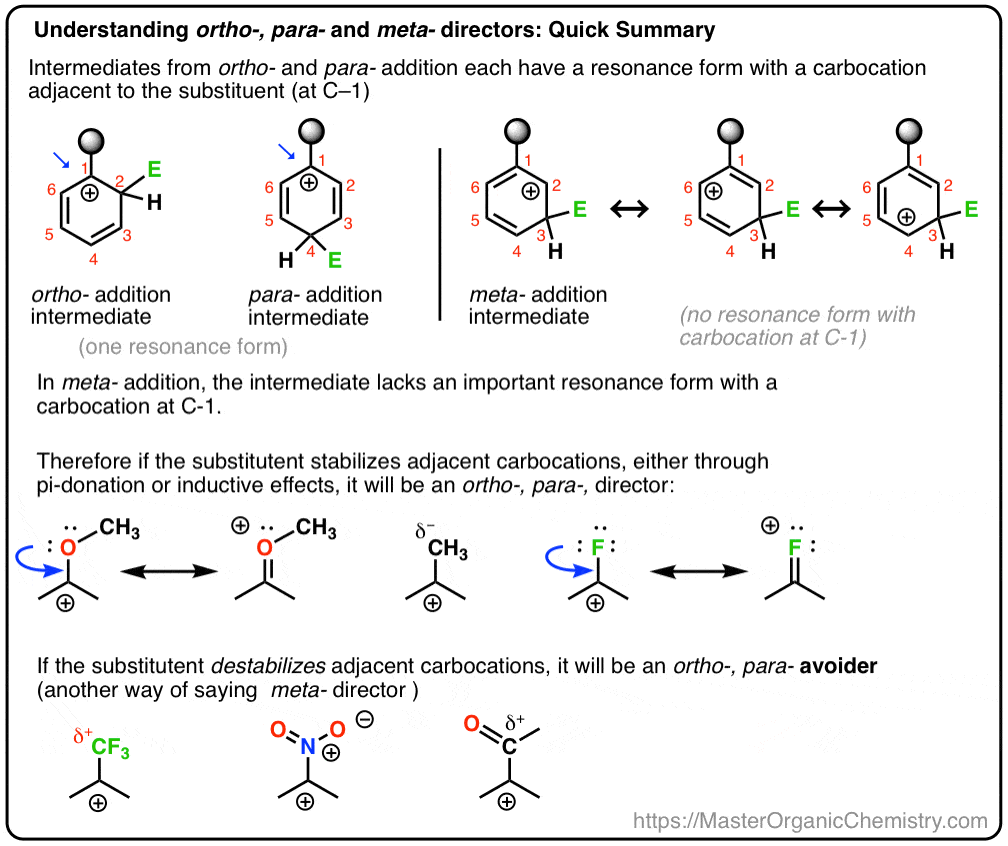
Table Of Contents
- Carbocations Are Stabilized By Adjacent Atoms With Lone Pairs
- Case Study #1: An ortho-,para- Director (OCH3)
- Yes, Oxygen Is Electronegative. But Donation Of Its Lone Pair More Than Makes Up For It!
- The Reaction-Energy Diagram For An Ortho Para Director
- Case Study #2: A meta- director (CF3).
- What We Call “meta– Directors” Are More Like “ortho-, para– Avoiders”
- The Reaction Energy Diagram For A meta- Director
- So Why Are Halogens Ortho-, Para- Directors?
- Notes
- Quiz Yourself!
- (Advanced) References and Further Reading
1. Carbocations Are Stabilized By Adjacent Atoms With Lone Pairs
In the previous post we introduced ortho- ,para- and meta- directors in electrophilic aromatic substitution. Previous to that we covered the mechanism of electrophilic aromatic substitution, and showed that the mechanism proceeds through a carbocation intermediate.
Today, we’re going to tie those two concepts together, and try to show that whether a substituent is an ortho-, para- or meta- director depends on how the substituent affects the stability of the carbocation intermediate.
And we’ll also see why an alternative name for meta- director might be, “ortho-, para- avoider”. : – )
Let’s think back to which factors increase the stability of carbocations. [See, “3 Factors that Stabilize Carbocations“]
Carbocations are electron-poor species with six electrons in their valence shell. So, any substituent which can donate electron density toward the carbocation will be stabilizing. This includes:
- electron-releasing substituents that can act as “sigma-donors” (e.g. many alkyl groups, which donate electron density through inductive effects [Note 1])
- adjacent atoms with lone pairs that can act as “pi donors” to the carbocation
- adjacent C–C pi bonds that can stabilize the carbocation through charge delocalization (“resonance stabilization”, in other words).
And factors which destabilize carbocations?
- any substituent that removes electron density from a carbocation, such as strong electron-withdrawing groups.
So here’s a quick quiz. Given everything written above, which of the two carbocations below will be more stable?

If you can answer this question well, you are most of the way towards understanding the difference between ortho-, para- and meta- directors.
Let’s examine two case studies. We’ll look at a generic electrophilic aromatic substitution reaction of benzene with an ortho-, para- director (methoxybenzene) and examine the intermediates that are obtained from attack at the ortho, meta, and para positions. Then we’ll perform the same exercise with a meta– director (trifluoromethylbenzene).
In the process, we’ll hope to understand why methoxybenzene favors ortho- and para– products while trifluoromethylbenzene favors the meta- product.
2. Case Study #1: An ortho-,para- Director (OCH3)
Electrophilic aromatic substitution of methoxybenzene tends to give ortho- and para- products with very little meta- . Here’s what happens in nitration, for example:
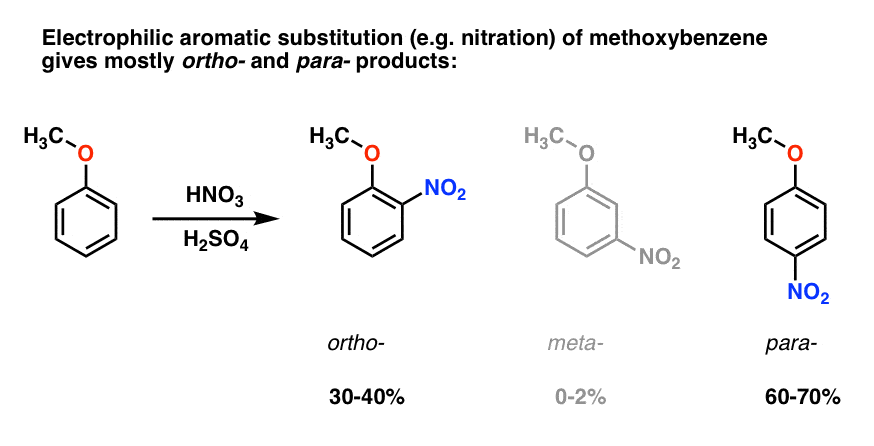
The para- product dominates (60-70%), with ortho- close behind (30-40%) and only a trace of the meta– .
Why?
3. Yes, Oxygen Is Electronegative. But Donation Of Its Lone Pair More Than Makes Up For It!
Here’s the pathway leading to the ortho- product. We break a C–C pi bond and form a new C–E bond (where E is intended to represent a generic electrophile), generating a resonance-stabilized carbocation:

If you look closely, you should note that we can form four resonance forms . Three of them bear full carbocations (on C1, C3, and C5), but it is the the fourth one – the resonance form where there is a C=O pi bond – which is particularly important. Why? In this resonance form, all of the carbon atoms have a full octet of electrons. That’s because the oxygen directly bonded to the ring can donate a lone pair to the adjacent carbocation, forming a pi bond. This is an example of pi donation.
Here’s the pathway for attack of the electrophile at the meta- position. Note the difference!

Attack of the electrophile at C-3 results in a carbocation which can be delocalized via resonance to C2, C4, and C6. However, there’s no way to “move” the carbocation to C1, which means that there’s no reasonable resonance form where all atoms have full octets.
This makes the meta- carbocation intermediate much less stable than the ortho- carbocation intermediate.
Finally, here is the reaction leading to the para- product:
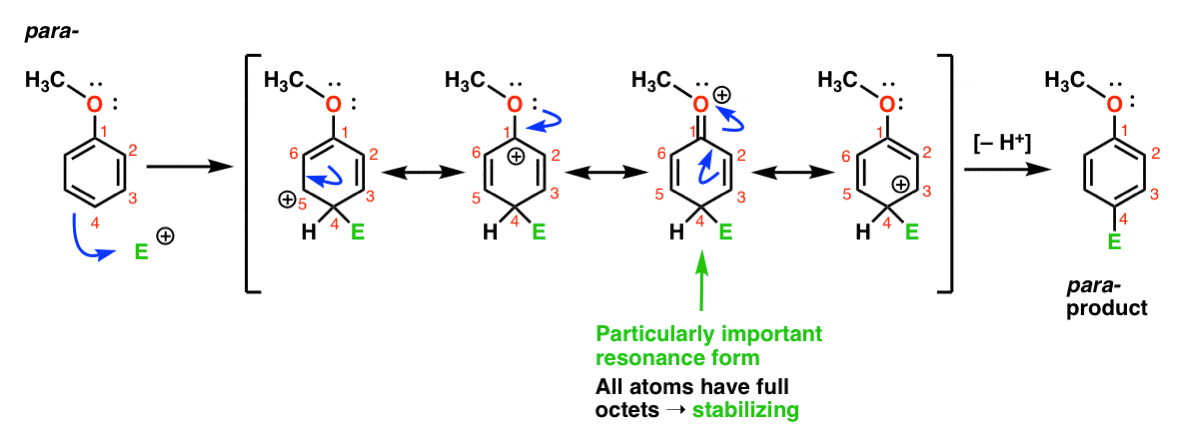
Here we can again draw resonance forms with carbocations on C1, C3, and C5, as well as a fourth resonance form where the attached oxygen atom donates an electron pair to the carbocation on C1, resulting in a full octet at carbon. This is a situation essentially the same as the ortho- intermediate.
So, by analysis of the resonance forms (and mark my word, you may well be asked to do the same on a test in the near future) we can see that the intermediate carbocations resulting from ortho- and para– addition are considerably more stable than the intermediate from meta– addition.
This explains is why ortho- and para- products dominate, and the meta- product is minor. [Note 2]
It might be helpful to visualize this by drawing a reaction energy diagram.
4. The Reaction-Energy Diagram For An Ortho Para Director
The transition state leading to the ortho- and para- addition products is much lower in energy than the meta– .
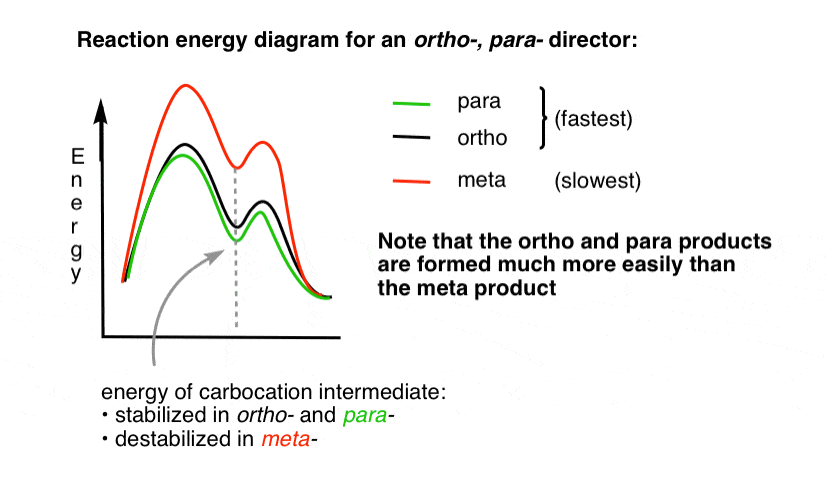
One question – why do you think that para- might be favored (e.g. 60%-70% yield for the para– product of nitration, above, versus 30-40% for ortho-) even though there are two ortho- positions and only one para- ?
Think about that for a minute, and we’ll address it below.
5. Case Study #2: A meta- director (CF3).
So what about CF3? Why does it give meta- products? Let’s do the same type of analysis.
Here’s the pathway leading to the ortho- product. As with the ortho- intermediate above, we can draw three resonance forms placing the carbocation on C1, C3, and C5, respectively.

So what’s different in this case?
What’s different is the presence of a strong electron withdrawing group (CF3) at C1, and this completely changes the ballgame.
As we’ve said, carbocations are destabilized by neighbors which withdraw electron-density. Therefore we would expect this to be a very minor resonance contributor, with the result that the positive charge is only delocalized over C3 and C5.
[Note: I’m avoiding saying that this is a “less stable” resonance form, because I want you to remember that resonance forms don’t really exist. What does exist is the resonance “hybrid”, which is built up of contributions from each of the resonance forms. You won’t be struck down by lightning if you refer to “more stable” or “less stable” resonance forms in casual conversation, so long as you always keep the “imaginary” nature of resonance forms in mind].
We’ve noted that CF3 is a meta- director. It’s reasonable to think that there’s something about the meta– that makes it particularly stable. By analyzing the intermediate for the meta– product below, can you see why?

Hmmm. There’s no intermediate where a carbon has a full octet. There are no particularly stable resonance forms.
It’s kind of “meh”, isn’t it?
6. What We Call “meta– Directors” Are More Like “ortho-, para– Avoiders”
On the other hand, there aren’t any particularly unstable resonance forms either. Since the positive charge is localized on C2, C4, and C6, a situation where the positive charge is directly adjacent to the electron-withdrawing CF3 group is avoided. And the positive charge is thus delocalized nicely throughout the ring, unlike in the ortho- situation, above.
So it’s a “less bad” intermediate than the ortho-.
Finally, the para- intermediate has the same problem as the ortho- ; an intermediate with a positive charge on C1, adjacent to the CF3.
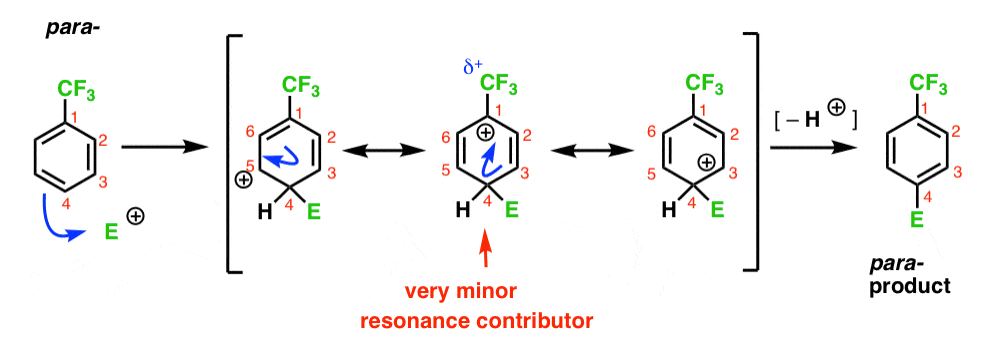
This results in only two important resonance forms, which leads to a less delocalized (and therefore less stable) carbocation intermediate.
Bottom line: the meta carbocation intermediate is more stable than either the ortho– or the para- intermediates.
But it’s not because the substituent itself has any stabilizing effect on the meta– intermediate. [And as we’ve seen, all meta- directing substituents are deactivating, meaning that they decrease the rate of reaction relative to H].
I’d argue that it’s more helpful to think of the meta- as less unstable than the ortho- and para– .
In this way, it’s not so much that CF3 is a meta- director, so much that it is an “ortho– , para– avoider. “
7. The Reaction Energy Diagram For A meta- Director
Here’s a sketch of the reaction energy diagram:
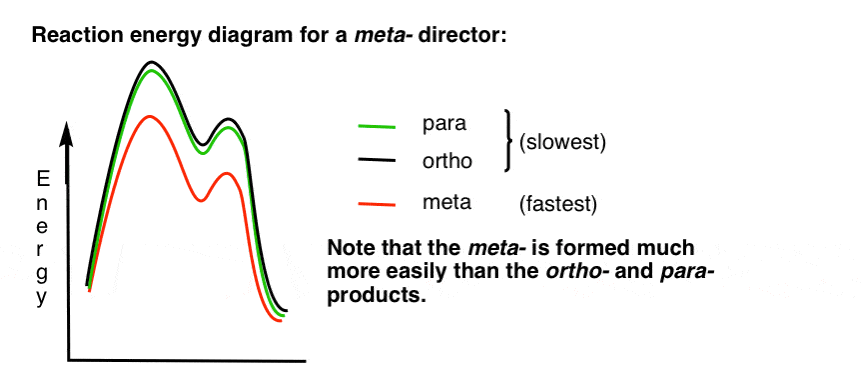
Alright.
Back to our original question. So which carbocation is more stable?
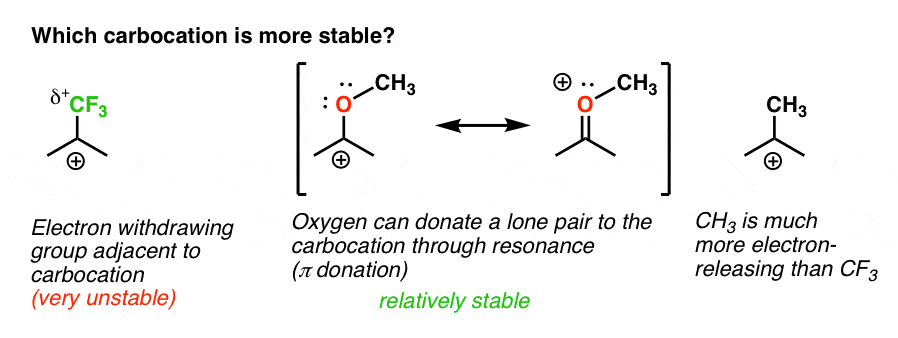
Clearly, the carbocation with an adjacent oxygen bearing a lone pair is far more stable than a carbocation adjacent to an electron-withdrawing group like CF3.
And that comprises the difference between an ortho-, para- director like OCH3 and a meta- director like CF3.
It’s worth noting that most alkyl groups (such as CH3 ) lack a lone pair, but are still ortho-, para- directors. This is consistent with everything we’ve learned before about how alkyl groups are generally stabilizing for carbocations- recall that carbocation stability generally increases with substitution [primary (least stable) < secondary < tertiary (most stable). ]
So about those para– products…
Why are para- products produced at a greater rate than ortho- ?
The answer is steric hindrance.
Attack at the para position is less encumbered by the substituent than attack at the ortho- positions are.
8. So Why Are Halogens Ortho-, Para- Directors?
This leaves us with the somewhat tricky example of halogens.
Why are fluorine, chlorine, bromine, and iodine ortho-, para- directors even though they are deactivating groups?
The answer should come as no surprise if you’ve been following along, but we’re going to leave this until the next post, because this one is long enough already.
Next post: Why are halogens ortho-, para- directors?
Notes
Related Articles
- Why are halogens ortho- para- directors?
- Activating and Deactivating Groups In Electrophilic Aromatic Substitution
- Electrophilic Aromatic Substitutions (1) – Halogenation of Benzene
- Electrophilic Aromatic Substitutions (2) – Nitration and Sulfonation
- EAS Reactions (3) – Friedel-Crafts Acylation and Friedel-Crafts Alkylation
- Electrophilic Aromatic Substitution Practice Problems (MOC Membership)
- Electrophilic Aromatic Substitution: Introduction
Note 1. Or hyperconjugation, which most textbooks (with the notable exception of Maitland Jones) generally avoid.
Note 2. It’s more correct to say that ortho- and para- products dominate because the transition states leading to these products are lower in energy, rather than the energies of the intermediates themselves. After all, it’s the energy of the transition states which determines the activation barrier, and therefore the reaction rate.
Note 3. Useful table with yields of meta– products for various substituted benzenes:
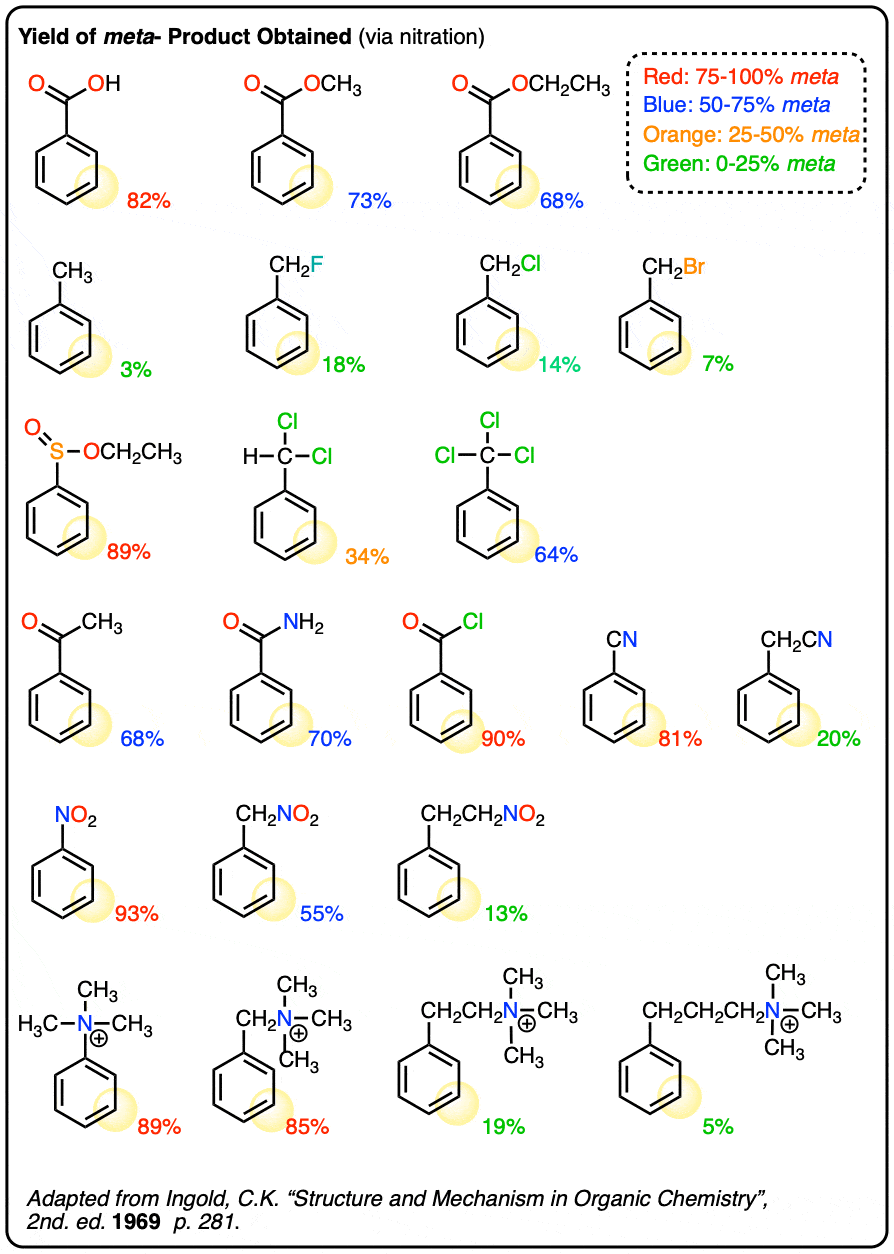
Quiz Yourself!
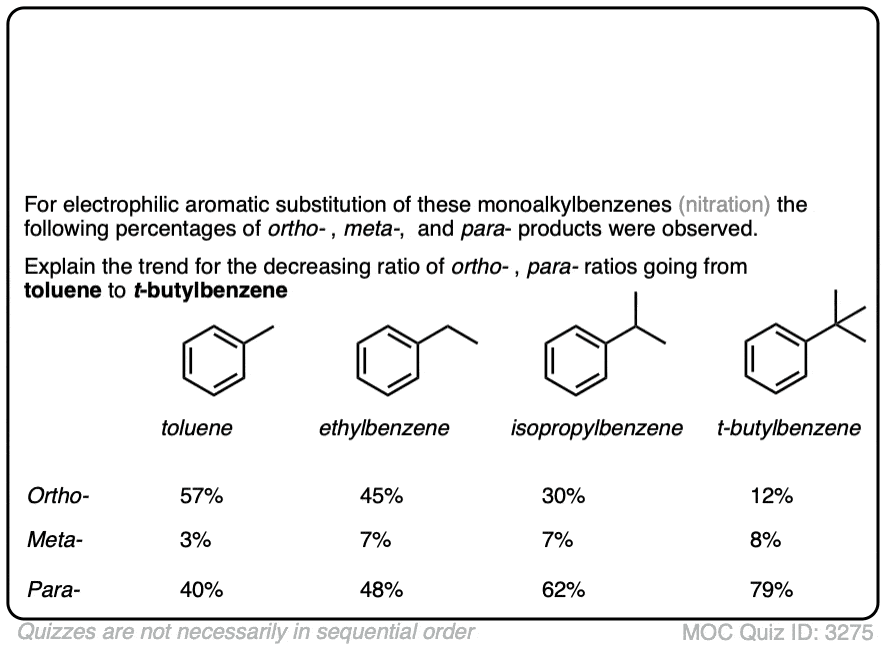 Click to Flip
Click to Flip

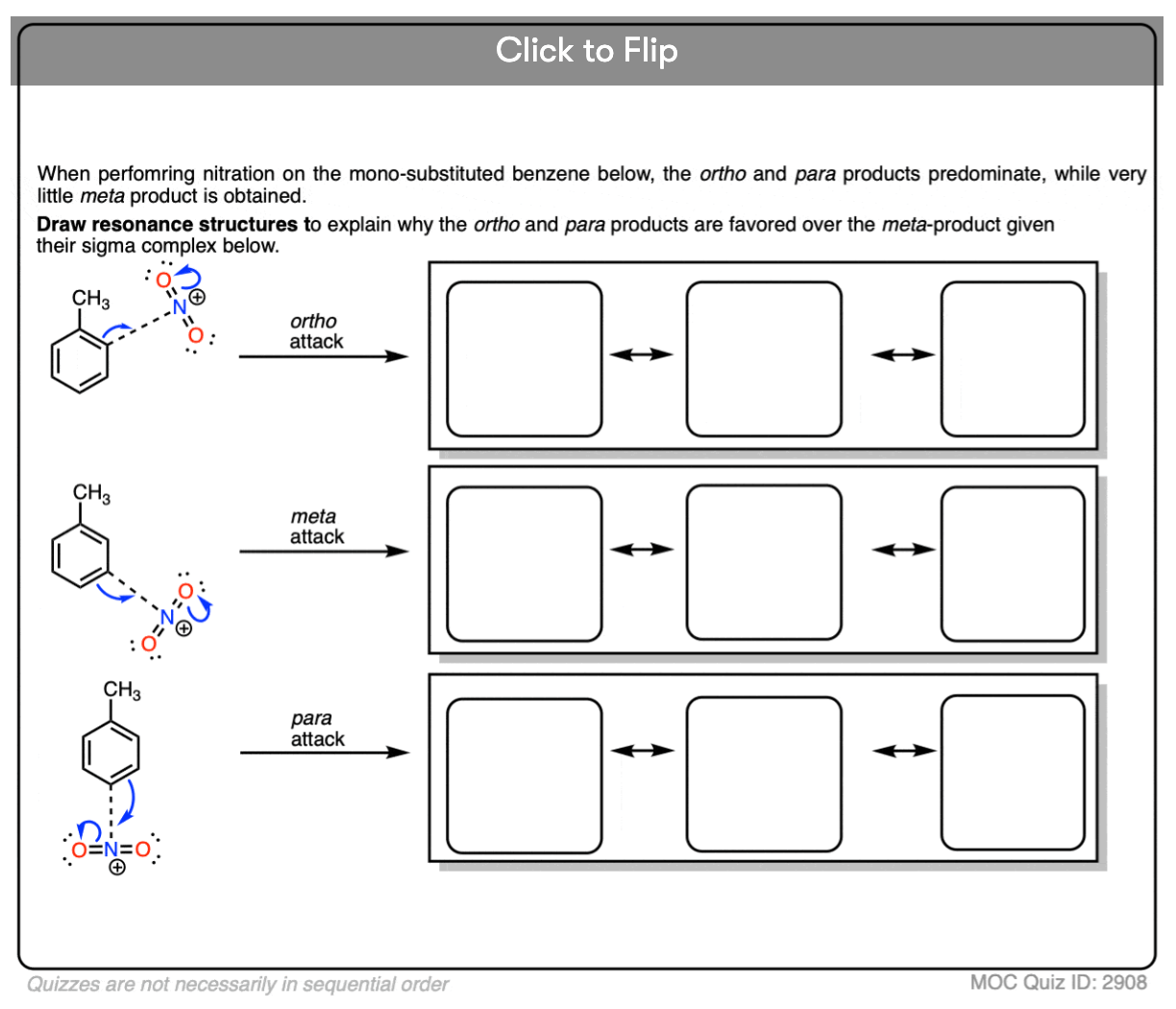
Become a MOC member to see the clickable quiz with answers on the back.
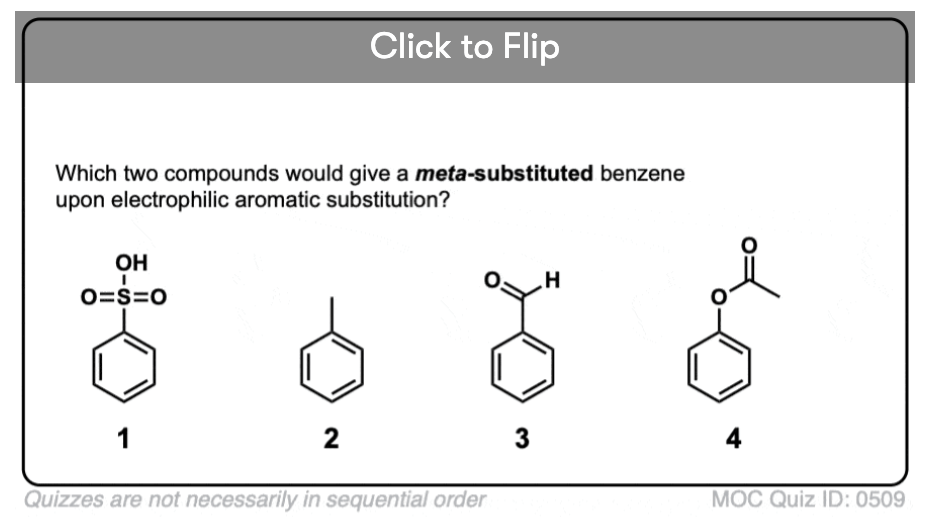
Become a MOC member to see the clickable quiz with answers on the back.
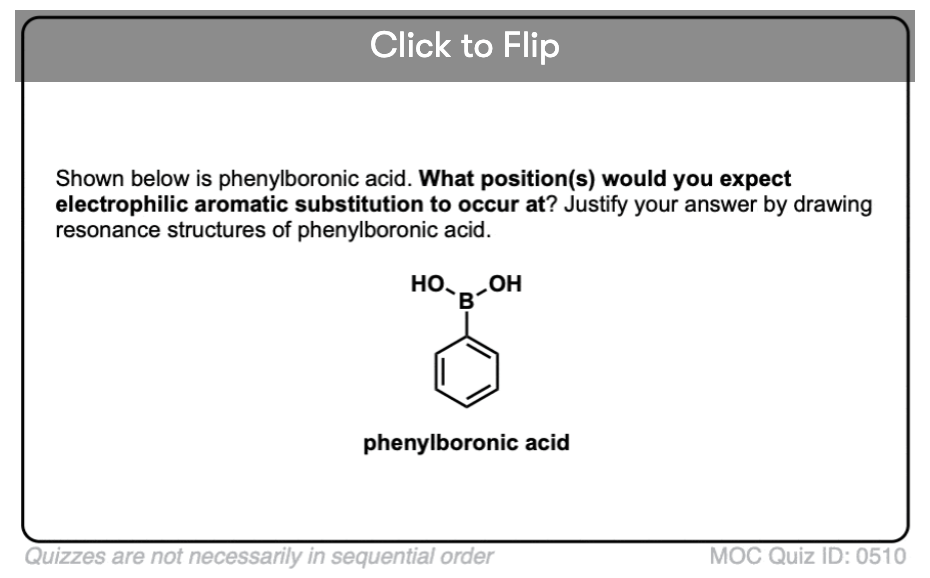
Become a MOC member to see the clickable quiz with answers on the back.
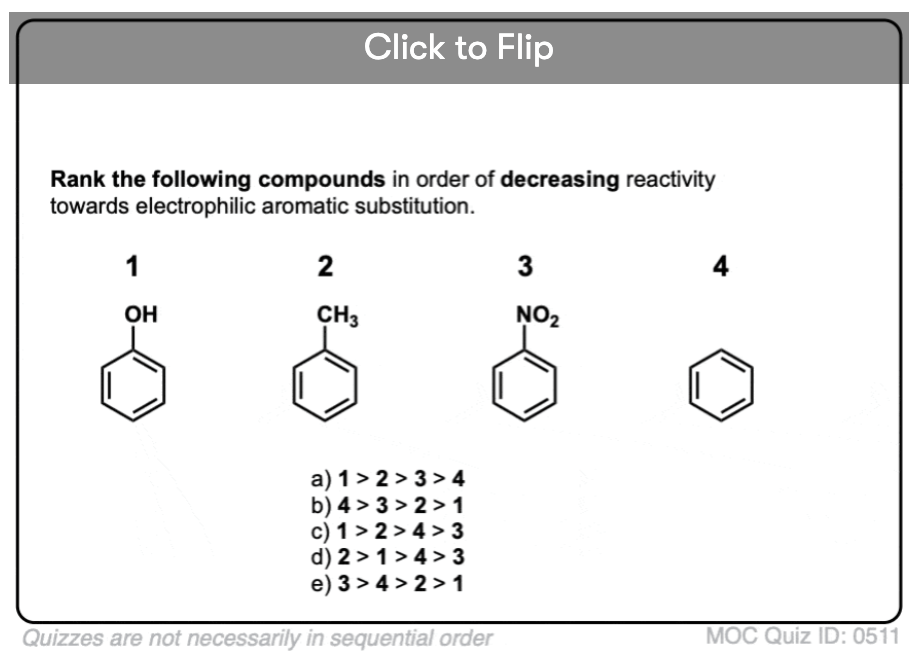
Become a MOC member to see the clickable quiz with answers on the back.
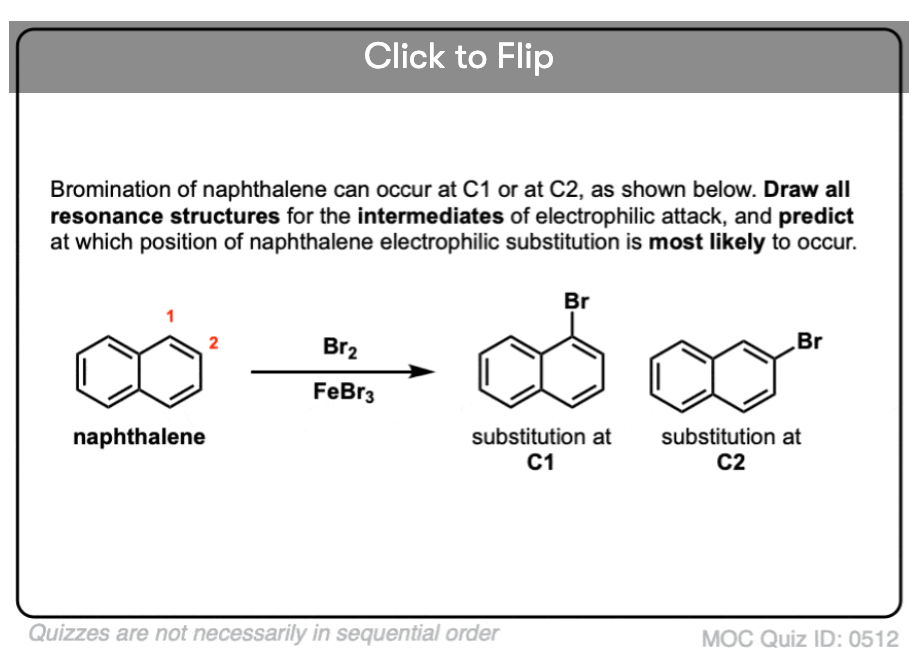
Become a MOC member to see the clickable quiz with answers on the back.
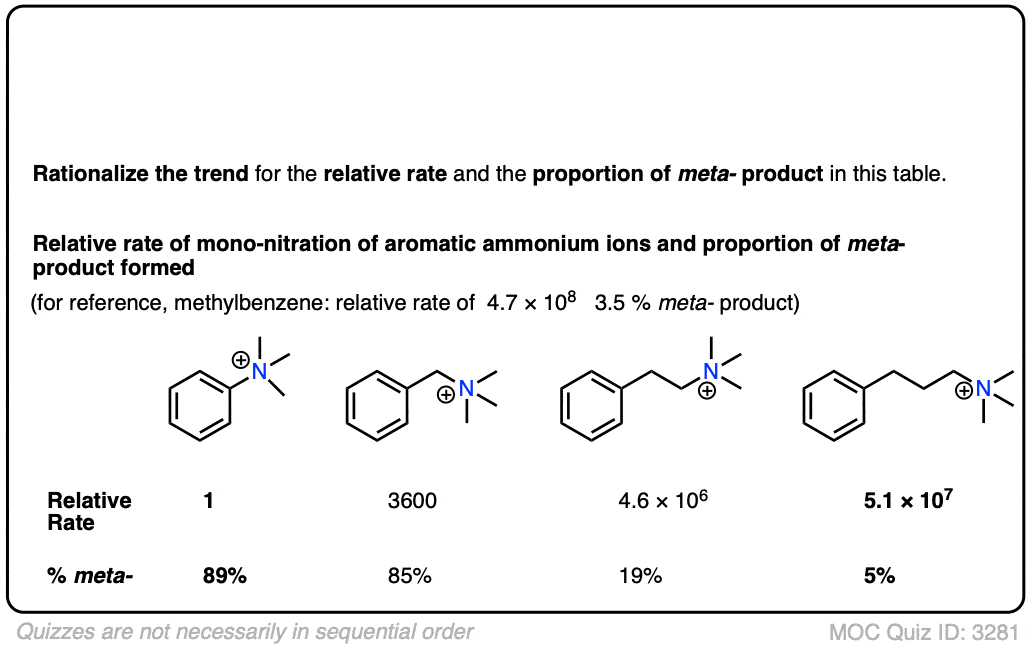 Click to Flip
Click to Flip
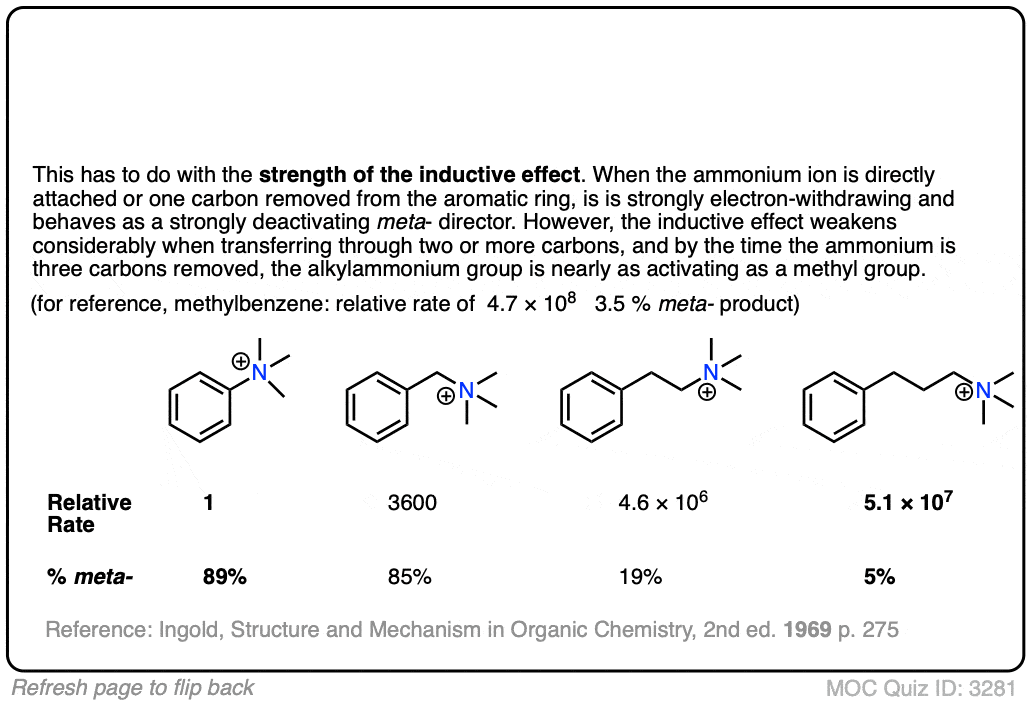
(Advanced) References and Further Reading
- A. F. Holleman, Die direkte Einführung von Substituenten in den Benzolkern
Rec. Trav. Chim. Pays-Bas 1910, 12, 455-456
DOI: 10.1002/recl.19100291205
A.F Holleman from 1910 said that ortho–para orientation is associated with activation and meta orientation with deactivation. - —The nature of the alternating effect in carbon chains. Part XXIII. Anomalous orientation by halogens, and its bearing on the problem of the ortho–para ratio, in aromatic substitution
Christopher Kelk Ingold and Charles Cyril Norrey Vass
J. Chem. Soc. 1928, 417-425
DOI: 10.1039/JR9280000417
This paper discusses directing effects in 1,2-dihalobenzenes. - Some observations concerning steric hindrance and the effects of substituents on the ortho : para ratio in aromatic substitution
P. B. D. de la Mare
J. Chem. Soc. 1949, 2871-2874
DOI: 10.1039/JR9490002871
In this paper, de la Mare discusses various factors that may account for a predominance of para over ortho selectivity, after dividing the yield of ortho product by 2 (since there are 2 ortho positions but only 1 para position in monosubstituted benzenes). - Volume effects of alkyl groups in aromatic compounds. Part V. The monosulphonation of p-cymene
R. J. W. Le Fèvre
J. Chem. Soc. 1934, 1501-1502
DOI: 10.1039/JR9340001501
In p-cymene, the major product obtained upon electrophilic sulfonation is the 2-product (ortho to the methyl group), likely due to sterics. - Effects of Alkyl Groups in Electrophilic Additions and Substitutions
COHN, H., HUGHES, E., JONES, M. and PEELING, M. G.
Nature 1952, 169, 291
DOI: 1038/169291a0
This paper has data comparing the nitration of t-butylbenzene and toluene. T-butylbenzene is much more p-directing than toluene (79.5% para for t-butylbenzene vs. 40% para for toluene), which is likely due to sterics (ortho approach is blocked by the bulkier t-butyl group). - Distribution of Isomers in the Mononitration of Ethyl- and Isopropylbenzene. Further Evidence for a Steric Effect in Isomer Distribution
Herbert C. Brown and W. Hallam Bonner
Journal of the American Chemical Society 1954, 76 (2), 605-606
DOI: 10.1021/ja01631a084
Table II in this paper illustrates that the ortho product obtained from nitration of monoalkylbenzenes decreases as the alkyl group gets larger (e.g. t-butylbenzene yields very little ortho product upon nitration compared to toluene). - —The nature of the alternating effect in carbon chains. Part XXII. An attempt further to define the probable mechanism of orientation in aromatic substitution
Christopher Kelk Ingold and Florence Ruth Shaw
J. Chem. Soc. 1927, 2918-2926
DOI: 10.1039/JR9270002918
An early paper by the influential Physical Organic Chemist, Prof. C. K. Ingold, stating that halogenobenzenes are inductively electron-withdrawing but simultaneously resonance-stabilizing. - The Anomalous Reactivity of Fluorobenzene in Electrophilic Aromatic Substitution and Related Phenomena
Joel Rosenthal and David I. Schuster
Journal of Chemical Education 2003, 80 (6), 679
DOI: 1021/ed080p679
A very interesting paper, suitable for curious undergrads, and discusses something that most practicing organic chemists will know empirically – fluorobenzene is almost as reactive as benzene in EAS or Friedel-Crafts reactions, which is counterintuitive when one considers electronic effects! - Organic chemistry
N. Haworth, C. K. Ingold, T. A. Henry
Ann. Rep. Prog. Chem. 1926, 23, 74-185
DOI: 10.1039/AR9262300074
An early paper discussing directing effects in EAS. Pp. 136 and 137 contain figures that depict the flow of electrons. Pg. 140 discusses meta-direction, which occurs for the ‘opposite’ reasons as o/p-direction by alkyl groups.
00 General Chemistry Review
01 Bonding, Structure, and Resonance
- How Do We Know Methane (CH4) Is Tetrahedral?
- Hybrid Orbitals and Hybridization
- How To Determine Hybridization: A Shortcut
- Orbital Hybridization And Bond Strengths
- Sigma bonds come in six varieties: Pi bonds come in one
- A Key Skill: How to Calculate Formal Charge
- The Four Intermolecular Forces and How They Affect Boiling Points
- 3 Trends That Affect Boiling Points
- How To Use Electronegativity To Determine Electron Density (and why NOT to trust formal charge)
- Introduction to Resonance
- How To Use Curved Arrows To Interchange Resonance Forms
- Evaluating Resonance Forms (1) - The Rule of Least Charges
- How To Find The Best Resonance Structure By Applying Electronegativity
- Evaluating Resonance Structures With Negative Charges
- Evaluating Resonance Structures With Positive Charge
- Exploring Resonance: Pi-Donation
- Exploring Resonance: Pi-acceptors
- In Summary: Evaluating Resonance Structures
- Drawing Resonance Structures: 3 Common Mistakes To Avoid
- How to apply electronegativity and resonance to understand reactivity
- Bond Hybridization Practice
- Structure and Bonding Practice Quizzes
- Resonance Structures Practice
02 Acid Base Reactions
- Introduction to Acid-Base Reactions
- Acid Base Reactions In Organic Chemistry
- The Stronger The Acid, The Weaker The Conjugate Base
- Walkthrough of Acid-Base Reactions (3) - Acidity Trends
- Five Key Factors That Influence Acidity
- Acid-Base Reactions: Introducing Ka and pKa
- How to Use a pKa Table
- The pKa Table Is Your Friend
- A Handy Rule of Thumb for Acid-Base Reactions
- Acid Base Reactions Are Fast
- pKa Values Span 60 Orders Of Magnitude
- How Protonation and Deprotonation Affect Reactivity
- Acid Base Practice Problems
03 Alkanes and Nomenclature
- Meet the (Most Important) Functional Groups
- Condensed Formulas: Deciphering What the Brackets Mean
- Hidden Hydrogens, Hidden Lone Pairs, Hidden Counterions
- Don't Be Futyl, Learn The Butyls
- Primary, Secondary, Tertiary, Quaternary In Organic Chemistry
- Branching, and Its Affect On Melting and Boiling Points
- The Many, Many Ways of Drawing Butane
- Wedge And Dash Convention For Tetrahedral Carbon
- Common Mistakes in Organic Chemistry: Pentavalent Carbon
- Table of Functional Group Priorities for Nomenclature
- Summary Sheet - Alkane Nomenclature
- Organic Chemistry IUPAC Nomenclature Demystified With A Simple Puzzle Piece Approach
- Boiling Point Quizzes
- Organic Chemistry Nomenclature Quizzes
04 Conformations and Cycloalkanes
- Staggered vs Eclipsed Conformations of Ethane
- Conformational Isomers of Propane
- Newman Projection of Butane (and Gauche Conformation)
- Introduction to Cycloalkanes
- Geometric Isomers In Small Rings: Cis And Trans Cycloalkanes
- Calculation of Ring Strain In Cycloalkanes
- Cycloalkanes - Ring Strain In Cyclopropane And Cyclobutane
- Cyclohexane Conformations
- Cyclohexane Chair Conformation: An Aerial Tour
- How To Draw The Cyclohexane Chair Conformation
- The Cyclohexane Chair Flip
- The Cyclohexane Chair Flip - Energy Diagram
- Substituted Cyclohexanes - Axial vs Equatorial
- Ranking The Bulkiness Of Substituents On Cyclohexanes: "A-Values"
- Cyclohexane Chair Conformation Stability: Which One Is Lower Energy?
- Fused Rings - Cis-Decalin and Trans-Decalin
- Naming Bicyclic Compounds - Fused, Bridged, and Spiro
- Bredt's Rule (And Summary of Cycloalkanes)
- Newman Projection Practice
- Cycloalkanes Practice Problems
05 A Primer On Organic Reactions
- The Most Important Question To Ask When Learning a New Reaction
- Curved Arrows (for reactions)
- Nucleophiles and Electrophiles
- The Three Classes of Nucleophiles
- Nucleophilicity vs. Basicity
- What Makes A Good Nucleophile?
- What Makes A Good Leaving Group?
- 3 Factors That Stabilize Carbocations
- Equilibrium and Energy Relationships
- 7 Factors that stabilize negative charge in organic chemistry
- 7 Factors That Stabilize Positive Charge in Organic Chemistry
- What's a Transition State?
- Hammond's Postulate
- Learning Organic Chemistry Reactions: A Checklist (PDF)
- Introduction to Oxidative Cleavage Reactions
06 Free Radical Reactions
- Bond Dissociation Energies = Homolytic Cleavage
- Free Radical Reactions
- 3 Factors That Stabilize Free Radicals
- What Factors Destabilize Free Radicals?
- Bond Strengths And Radical Stability
- Free Radical Initiation: Why Is "Light" Or "Heat" Required?
- Initiation, Propagation, Termination
- Monochlorination Products Of Propane, Pentane, And Other Alkanes
- Selectivity In Free Radical Reactions
- Selectivity in Free Radical Reactions: Bromination vs. Chlorination
- Halogenation At Tiffany's
- Allylic Bromination
- Bonus Topic: Allylic Rearrangements
- In Summary: Free Radicals
- Synthesis (2) - Reactions of Alkanes
- Free Radicals Practice Quizzes
07 Stereochemistry and Chirality
- Types of Isomers: Constitutional Isomers, Stereoisomers, Enantiomers, and Diastereomers
- How To Draw The Enantiomer Of A Chiral Molecule
- How To Draw A Bond Rotation
- Introduction to Assigning (R) and (S): The Cahn-Ingold-Prelog Rules
- Assigning Cahn-Ingold-Prelog (CIP) Priorities (2) - The Method of Dots
- Enantiomers vs Diastereomers vs The Same? Two Methods For Solving Problems
- Assigning R/S To Newman Projections (And Converting Newman To Line Diagrams)
- How To Determine R and S Configurations On A Fischer Projection
- The Meso Trap
- Optical Rotation, Optical Activity, and Specific Rotation
- Optical Purity and Enantiomeric Excess
- What's a Racemic Mixture?
- Chiral Allenes And Chiral Axes
- Stereochemistry Practice Problems and Quizzes
08 Substitution Reactions
- Nucleophilic Substitution Reactions - Introduction
- Two Types of Nucleophilic Substitution Reactions
- The SN2 Mechanism
- Why the SN2 Reaction Is Powerful
- The SN1 Mechanism
- The Conjugate Acid Is A Better Leaving Group
- Comparing the SN1 and SN2 Reactions
- Polar Protic? Polar Aprotic? Nonpolar? All About Solvents
- Steric Hindrance is Like a Fat Goalie
- Common Blind Spot: Intramolecular Reactions
- Substitution Practice - SN1
- Substitution Practice - SN2
09 Elimination Reactions
- Elimination Reactions (1): Introduction And The Key Pattern
- Elimination Reactions (2): The Zaitsev Rule
- Elimination Reactions Are Favored By Heat
- Two Elimination Reaction Patterns
- The E1 Reaction
- The E2 Mechanism
- E1 vs E2: Comparing the E1 and E2 Reactions
- Antiperiplanar Relationships: The E2 Reaction and Cyclohexane Rings
- Bulky Bases in Elimination Reactions
- Comparing the E1 vs SN1 Reactions
- Elimination (E1) Reactions With Rearrangements
- E1cB - Elimination (Unimolecular) Conjugate Base
- Elimination (E1) Practice Problems And Solutions
- Elimination (E2) Practice Problems and Solutions
10 Rearrangements
11 SN1/SN2/E1/E2 Decision
- Identifying Where Substitution and Elimination Reactions Happen
- Deciding SN1/SN2/E1/E2 (1) - The Substrate
- Deciding SN1/SN2/E1/E2 (2) - The Nucleophile/Base
- SN1 vs E1 and SN2 vs E2 : The Temperature
- Deciding SN1/SN2/E1/E2 - The Solvent
- Wrapup: The Key Factors For Determining SN1/SN2/E1/E2
- Alkyl Halide Reaction Map And Summary
- SN1 SN2 E1 E2 Practice Problems
12 Alkene Reactions
- E and Z Notation For Alkenes (+ Cis/Trans)
- Alkene Stability
- Alkene Addition Reactions: "Regioselectivity" and "Stereoselectivity" (Syn/Anti)
- Stereoselective and Stereospecific Reactions
- Hydrohalogenation of Alkenes and Markovnikov's Rule
- Hydration of Alkenes With Aqueous Acid
- Rearrangements in Alkene Addition Reactions
- Halogenation of Alkenes and Halohydrin Formation
- Oxymercuration Demercuration of Alkenes
- Hydroboration Oxidation of Alkenes
- m-CPBA (meta-chloroperoxybenzoic acid)
- OsO4 (Osmium Tetroxide) for Dihydroxylation of Alkenes
- Palladium on Carbon (Pd/C) for Catalytic Hydrogenation of Alkenes
- Cyclopropanation of Alkenes
- A Fourth Alkene Addition Pattern - Free Radical Addition
- Alkene Reactions: Ozonolysis
- Summary: Three Key Families Of Alkene Reaction Mechanisms
- Synthesis (4) - Alkene Reaction Map, Including Alkyl Halide Reactions
- Alkene Reactions Practice Problems
13 Alkyne Reactions
- Acetylides from Alkynes, And Substitution Reactions of Acetylides
- Partial Reduction of Alkynes With Lindlar's Catalyst
- Partial Reduction of Alkynes With Na/NH3 To Obtain Trans Alkenes
- Alkyne Hydroboration With "R2BH"
- Hydration and Oxymercuration of Alkynes
- Hydrohalogenation of Alkynes
- Alkyne Halogenation: Bromination, Chlorination, and Iodination of Alkynes
- Alkyne Reactions - The "Concerted" Pathway
- Alkenes To Alkynes Via Halogenation And Elimination Reactions
- Alkynes Are A Blank Canvas
- Synthesis (5) - Reactions of Alkynes
- Alkyne Reactions Practice Problems With Answers
14 Alcohols, Epoxides and Ethers
- Alcohols - Nomenclature and Properties
- Alcohols Can Act As Acids Or Bases (And Why It Matters)
- Alcohols - Acidity and Basicity
- The Williamson Ether Synthesis
- Ethers From Alkenes, Tertiary Alkyl Halides and Alkoxymercuration
- Alcohols To Ethers via Acid Catalysis
- Cleavage Of Ethers With Acid
- Epoxides - The Outlier Of The Ether Family
- Opening of Epoxides With Acid
- Epoxide Ring Opening With Base
- Making Alkyl Halides From Alcohols
- Tosylates And Mesylates
- PBr3 and SOCl2
- Elimination Reactions of Alcohols
- Elimination of Alcohols To Alkenes With POCl3
- Alcohol Oxidation: "Strong" and "Weak" Oxidants
- Demystifying The Mechanisms of Alcohol Oxidations
- Protecting Groups For Alcohols
- Thiols And Thioethers
- Calculating the oxidation state of a carbon
- Oxidation and Reduction in Organic Chemistry
- Oxidation Ladders
- SOCl2 Mechanism For Alcohols To Alkyl Halides: SN2 versus SNi
- Alcohol Reactions Roadmap (PDF)
- Alcohol Reaction Practice Problems
- Epoxide Reaction Quizzes
- Oxidation and Reduction Practice Quizzes
15 Organometallics
- What's An Organometallic?
- Formation of Grignard and Organolithium Reagents
- Organometallics Are Strong Bases
- Reactions of Grignard Reagents
- Protecting Groups In Grignard Reactions
- Synthesis Problems Involving Grignard Reagents
- Grignard Reactions And Synthesis (2)
- Organocuprates (Gilman Reagents): How They're Made
- Gilman Reagents (Organocuprates): What They're Used For
- The Heck, Suzuki, and Olefin Metathesis Reactions (And Why They Don't Belong In Most Introductory Organic Chemistry Courses)
- Reaction Map: Reactions of Organometallics
- Grignard Practice Problems
16 Spectroscopy
- Degrees of Unsaturation (or IHD, Index of Hydrogen Deficiency)
- Conjugation And Color (+ How Bleach Works)
- Introduction To UV-Vis Spectroscopy
- UV-Vis Spectroscopy: Absorbance of Carbonyls
- UV-Vis Spectroscopy: Practice Questions
- Bond Vibrations, Infrared Spectroscopy, and the "Ball and Spring" Model
- Infrared Spectroscopy: A Quick Primer On Interpreting Spectra
- IR Spectroscopy: 4 Practice Problems
- 1H NMR: How Many Signals?
- Homotopic, Enantiotopic, Diastereotopic
- Diastereotopic Protons in 1H NMR Spectroscopy: Examples
- 13-C NMR - How Many Signals
- Liquid Gold: Pheromones In Doe Urine
- Natural Product Isolation (1) - Extraction
- Natural Product Isolation (2) - Purification Techniques, An Overview
- Structure Determination Case Study: Deer Tarsal Gland Pheromone
17 Dienes and MO Theory
- What To Expect In Organic Chemistry 2
- Are these molecules conjugated?
- Conjugation And Resonance In Organic Chemistry
- Bonding And Antibonding Pi Orbitals
- Molecular Orbitals of The Allyl Cation, Allyl Radical, and Allyl Anion
- Pi Molecular Orbitals of Butadiene
- Reactions of Dienes: 1,2 and 1,4 Addition
- Thermodynamic and Kinetic Products
- More On 1,2 and 1,4 Additions To Dienes
- s-cis and s-trans
- The Diels-Alder Reaction
- Cyclic Dienes and Dienophiles in the Diels-Alder Reaction
- Stereochemistry of the Diels-Alder Reaction
- Exo vs Endo Products In The Diels Alder: How To Tell Them Apart
- HOMO and LUMO In the Diels Alder Reaction
- Why Are Endo vs Exo Products Favored in the Diels-Alder Reaction?
- Diels-Alder Reaction: Kinetic and Thermodynamic Control
- The Retro Diels-Alder Reaction
- The Intramolecular Diels Alder Reaction
- Regiochemistry In The Diels-Alder Reaction
- The Cope and Claisen Rearrangements
- Electrocyclic Reactions
- Electrocyclic Ring Opening And Closure (2) - Six (or Eight) Pi Electrons
- Diels Alder Practice Problems
- Molecular Orbital Theory Practice
18 Aromaticity
- Introduction To Aromaticity
- Rules For Aromaticity
- Huckel's Rule: What Does 4n+2 Mean?
- Aromatic, Non-Aromatic, or Antiaromatic? Some Practice Problems
- Antiaromatic Compounds and Antiaromaticity
- The Pi Molecular Orbitals of Benzene
- The Pi Molecular Orbitals of Cyclobutadiene
- Frost Circles
- Aromaticity Practice Quizzes
19 Reactions of Aromatic Molecules
- Electrophilic Aromatic Substitution: Introduction
- Activating and Deactivating Groups In Electrophilic Aromatic Substitution
- Electrophilic Aromatic Substitution - The Mechanism
- Ortho-, Para- and Meta- Directors in Electrophilic Aromatic Substitution
- Understanding Ortho, Para, and Meta Directors
- Why are halogens ortho- para- directors?
- Disubstituted Benzenes: The Strongest Electron-Donor "Wins"
- Electrophilic Aromatic Substitutions (1) - Halogenation of Benzene
- Electrophilic Aromatic Substitutions (2) - Nitration and Sulfonation
- EAS Reactions (3) - Friedel-Crafts Acylation and Friedel-Crafts Alkylation
- Intramolecular Friedel-Crafts Reactions
- Nucleophilic Aromatic Substitution (NAS)
- Nucleophilic Aromatic Substitution (2) - The Benzyne Mechanism
- Reactions on the "Benzylic" Carbon: Bromination And Oxidation
- The Wolff-Kishner, Clemmensen, And Other Carbonyl Reductions
- More Reactions on the Aromatic Sidechain: Reduction of Nitro Groups and the Baeyer Villiger
- Aromatic Synthesis (1) - "Order Of Operations"
- Synthesis of Benzene Derivatives (2) - Polarity Reversal
- Aromatic Synthesis (3) - Sulfonyl Blocking Groups
- Birch Reduction
- Synthesis (7): Reaction Map of Benzene and Related Aromatic Compounds
- Aromatic Reactions and Synthesis Practice
- Electrophilic Aromatic Substitution Practice Problems
20 Aldehydes and Ketones
- What's The Alpha Carbon In Carbonyl Compounds?
- Nucleophilic Addition To Carbonyls
- Aldehydes and Ketones: 14 Reactions With The Same Mechanism
- Sodium Borohydride (NaBH4) Reduction of Aldehydes and Ketones
- Grignard Reagents For Addition To Aldehydes and Ketones
- Wittig Reaction
- Hydrates, Hemiacetals, and Acetals
- Imines - Properties, Formation, Reactions, and Mechanisms
- All About Enamines
- Breaking Down Carbonyl Reaction Mechanisms: Reactions of Anionic Nucleophiles (Part 2)
- Aldehydes Ketones Reaction Practice
21 Carboxylic Acid Derivatives
- Nucleophilic Acyl Substitution (With Negatively Charged Nucleophiles)
- Addition-Elimination Mechanisms With Neutral Nucleophiles (Including Acid Catalysis)
- Basic Hydrolysis of Esters - Saponification
- Transesterification
- Proton Transfer
- Fischer Esterification - Carboxylic Acid to Ester Under Acidic Conditions
- Lithium Aluminum Hydride (LiAlH4) For Reduction of Carboxylic Acid Derivatives
- LiAlH[Ot-Bu]3 For The Reduction of Acid Halides To Aldehydes
- Di-isobutyl Aluminum Hydride (DIBAL) For The Partial Reduction of Esters and Nitriles
- Amide Hydrolysis
- Thionyl Chloride (SOCl2) And Conversion of Carboxylic Acids to Acid Halides
- Diazomethane (CH2N2)
- Carbonyl Chemistry: Learn Six Mechanisms For the Price Of One
- Making Music With Mechanisms (PADPED)
- Carboxylic Acid Derivatives Practice Questions
22 Enols and Enolates
- Keto-Enol Tautomerism
- Enolates - Formation, Stability, and Simple Reactions
- Kinetic Versus Thermodynamic Enolates
- Aldol Addition and Condensation Reactions
- Reactions of Enols - Acid-Catalyzed Aldol, Halogenation, and Mannich Reactions
- Claisen Condensation and Dieckmann Condensation
- Decarboxylation
- The Malonic Ester and Acetoacetic Ester Synthesis
- The Michael Addition Reaction and Conjugate Addition
- The Robinson Annulation
- Haloform Reaction
- The Hell–Volhard–Zelinsky Reaction
- Enols and Enolates Practice Quizzes
23 Amines
- The Amide Functional Group: Properties, Synthesis, and Nomenclature
- Basicity of Amines And pKaH
- 5 Key Basicity Trends of Amines
- The Mesomeric Effect And Aromatic Amines
- Nucleophilicity of Amines
- Alkylation of Amines (Sucks!)
- Reductive Amination
- The Gabriel Synthesis
- Some Reactions of Azides
- The Hofmann Elimination
- The Hofmann and Curtius Rearrangements
- The Cope Elimination
- Protecting Groups for Amines - Carbamates
- The Strecker Synthesis of Amino Acids
- Introduction to Peptide Synthesis
- Reactions of Diazonium Salts: Sandmeyer and Related Reactions
- Amine Practice Questions
24 Carbohydrates
- D and L Notation For Sugars
- Pyranoses and Furanoses: Ring-Chain Tautomerism In Sugars
- What is Mutarotation?
- Reducing Sugars
- The Big Damn Post Of Carbohydrate-Related Chemistry Definitions
- The Haworth Projection
- Converting a Fischer Projection To A Haworth (And Vice Versa)
- Reactions of Sugars: Glycosylation and Protection
- The Ruff Degradation and Kiliani-Fischer Synthesis
- Isoelectric Points of Amino Acids (and How To Calculate Them)
- Carbohydrates Practice
- Amino Acid Quizzes
25 Fun and Miscellaneous
- A Gallery of Some Interesting Molecules From Nature
- Screw Organic Chemistry, I'm Just Going To Write About Cats
- On Cats, Part 1: Conformations and Configurations
- On Cats, Part 2: Cat Line Diagrams
- On Cats, Part 4: Enantiocats
- On Cats, Part 6: Stereocenters
- Organic Chemistry Is Shit
- The Organic Chemistry Behind "The Pill"
- Maybe they should call them, "Formal Wins" ?
- Why Do Organic Chemists Use Kilocalories?
- The Principle of Least Effort
- Organic Chemistry GIFS - Resonance Forms
- Reproducibility In Organic Chemistry
- What Holds The Nucleus Together?
- How Reactions Are Like Music
- Organic Chemistry and the New MCAT
26 Organic Chemistry Tips and Tricks
- Common Mistakes: Formal Charges Can Mislead
- Partial Charges Give Clues About Electron Flow
- Draw The Ugly Version First
- Organic Chemistry Study Tips: Learn the Trends
- The 8 Types of Arrows In Organic Chemistry, Explained
- Top 10 Skills To Master Before An Organic Chemistry 2 Final
- Common Mistakes with Carbonyls: Carboxylic Acids... Are Acids!
- Planning Organic Synthesis With "Reaction Maps"
- Alkene Addition Pattern #1: The "Carbocation Pathway"
- Alkene Addition Pattern #2: The "Three-Membered Ring" Pathway
- Alkene Addition Pattern #3: The "Concerted" Pathway
- Number Your Carbons!
- The 4 Major Classes of Reactions in Org 1
- How (and why) electrons flow
- Grossman's Rule
- Three Exam Tips
- A 3-Step Method For Thinking Through Synthesis Problems
- Putting It Together
- Putting Diels-Alder Products in Perspective
- The Ups and Downs of Cyclohexanes
- The Most Annoying Exceptions in Org 1 (Part 1)
- The Most Annoying Exceptions in Org 1 (Part 2)
- The Marriage May Be Bad, But the Divorce Still Costs Money
- 9 Nomenclature Conventions To Know
- Nucleophile attacks Electrophile
27 Case Studies of Successful O-Chem Students
- Success Stories: How Corina Got The The "Hard" Professor - And Got An A+ Anyway
- How Helena Aced Organic Chemistry
- From a "Drop" To B+ in Org 2 – How A Hard Working Student Turned It Around
- How Serge Aced Organic Chemistry
- Success Stories: How Zach Aced Organic Chemistry 1
- Success Stories: How Kari Went From C– to B+
- How Esther Bounced Back From a "C" To Get A's In Organic Chemistry 1 And 2
- How Tyrell Got The Highest Grade In Her Organic Chemistry Course
- This Is Why Students Use Flashcards
- Success Stories: How Stu Aced Organic Chemistry
- How John Pulled Up His Organic Chemistry Exam Grades
- Success Stories: How Nathan Aced Organic Chemistry (Without It Taking Over His Life)
- How Chris Aced Org 1 and Org 2
- Interview: How Jay Got an A+ In Organic Chemistry
- How to Do Well in Organic Chemistry: One Student's Advice
- "America's Top TA" Shares His Secrets For Teaching O-Chem
- "Organic Chemistry Is Like..." - A Few Metaphors
- How To Do Well In Organic Chemistry: Advice From A Tutor
- Guest post: "I went from being afraid of tests to actually looking forward to them".
Thank you for great explanations! In this article, the reason why some substituents “direct” the electrophile to certain position is explained by resonance. However, since resonance is an imaginary concept that doesn’t actually take place in actual interaction of molecules, I have been trying to explain every resonance-induced stability with MO theory.
Well… it just didn’t work this time. I tried to explain the stability with idea based on pi system that the longer the conjugation, the more stable it is, and it could explain ortho and meta position (ortho has 6 atoms in pi system, where meta has two cases of 5 atoms in pi system) but it couldn’t explain the case of para position (one case of 4 atoms, one case of 5 atoms). And I wasn’t even sure that if using the pi system was the right approach(also having many different ways of conjugation that has different number of atoms in the system just felt so wrong).
So I went on to molecular calculation using MolCalc, and got the result that matches our expectations, but I still couldn’t explain it with MO theory.
Even if it is just what Schrödinger equation and Hückel method says, there still has to be the reason for that… and I just can’t find it but I’m dying to find it. Could you help?
Hi, I would highly recommend Ian Fleming’s “Frontier Orbitals and Organic Chemical Reactions” for a discussion of MO theory. Mostly covers pericyclic reactions, but it also does a frontier orbital treatment of electrophilic aromatic substitution.
https://archive.org/details/frontierorbitals0000flem
Is (-NHCOPh) an Ortho/Para-directing group like (-NHCOCH3) ?
Will be obliged if you can give some explanation.
Yes. Same effect. Lone pair on nitrogen can stabilize an adjacent carbocation.
thank you for your nice explanation. but I have a question. why you said ‘most’ alkyl groups not all of them lack a lone pair?
A carbanion would have a lone pair.
*xylen :)
thanks for the article
why ortho-zailen and para-zailen tend to change into meta-zailen in 80 degrees Celsius in presence of HCL and AlCl3
but in 0 degree Celsius it doesn’t happen
how it happens?
depends on HCL or something else?
Sir it is very beautiful explanation i understood complete concept of ortho , meta and para . Suprb explanation. Thankyou very much sir for .
On the fourth resonance structure for the para addition of any E+ to the benzene ring with OCH3, wouldn’t there be a second pair of electrons on the Oxygen after the arrows push them from the double bond up to the Oxygen?
Yes, you are correct. I will put this in the corrections queue.
okay I just found your page explaining this exact problem never mind! Thank you!
if you have a benzene ring with two substituents ( lets say OCH3 and an ethyl) that are both ortho/para directors which are on the 1,3 carbons and you react it with Br2/FeBr3, would you expect to have major products be with the Br on the ortho and meta positions of the higher ranked directing and activating substituent (OCH3) or would the major products be the Br on the ortho and meta positions for both substituents?
How about larger aromatic systems, such as naphthalene and anthracene. Do the directing effects/rules still hold?
It can be much more complicated. For naphthalene, for instance, there are two possible products, and it turns out that substitution on the 1-position is kinetically favored whereas substitution on the 2-position will occur under equilibrating (thermodynamic) conditions. In anthracene, the central aromatic ring (9- and 10- positions) is the easiest to break (and can even undergo diels-alder reactions).
I had doubt about these all directors but now my mind is clear thank you for explaining it in a simple language
Glad to hear it Rutuja – thanks for leaving the comment.
Beautiful explanations and illustrations! Thanks James!
Hey, glad you liked it Dave. Hope it was useful.